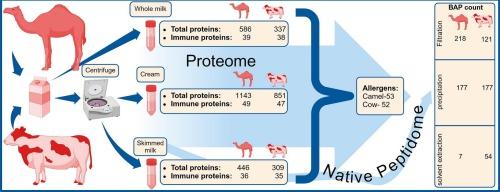超越营养:探索牛奶和阿拉伯骆驼奶中的免疫蛋白、生物活性肽和过敏原
IF 9.8
1区 农林科学
Q1 CHEMISTRY, APPLIED
引用次数: 0
摘要
牛奶在乳制品领域占据主导地位,但由于免疫蛋白和生物活性肽(bp)对健康的益处,替代牛奶来源正受到关注。分离影响蛋白质的回收率和组成。在这里,作为奶油的分离产生了最高的蛋白质产量,鉴定出1143个骆驼蛋白和851个牛蛋白。奶油部分含有明显更高浓度的免疫系统相关蛋白质。直接过滤法和蛋白质沉淀法的平均BP检测值分别为170和177,而溶剂萃取法的平均BP检测值为31。考虑到潜在的致敏蛋白,鉴定出53个(骆驼)和52个(牛)。其中,62% %的奶牛潜在过敏原在骆驼奶中有同源的对应物。而在驼奶中未检出主要的乳过敏原β-乳球蛋白(β-Lg)。我们的研究结果为骆驼和牛奶产品提供了一个全面的蛋白质组学资源,绘制了影响健康的潜在过敏原和bp。本文章由计算机程序翻译,如有差异,请以英文原文为准。

Beyond nutrition: Exploring immune proteins, bioactive peptides, and allergens in cow and Arabian camel milk
Bovine milk has dominated the dairy segment, yet alternative milk sources are gaining attention due to perceived superior health benefits, with immune proteins and bioactive peptides (BPs) contributing to these benefits. Fractionation affected protein recovery and composition. Here, the fractionation as cream resulted in the highest yield of proteins, identifying 1143 camel and 851 cow proteins. The cream fraction contained a significantly higher concentration of immune system-related proteins. Straightforward filtration and protein precipitation methods achieved average BP detections of 170 and 177, compared to 31 by a solvent-solvent extraction method. Considering potentially allergenic proteins, 53 (camel) and 52 (cow) were identified. Of these, 62 % of the potential allergens in cow, had orthologous counterparts in camel milk. However, the major milk allergen β-lactoglobulin (β-Lg) was not detected in camel milk. Our results provide a comprehensive proteomic resource of camel and cow milk products, mapping potential allergens and BPs that affect health.
求助全文
通过发布文献求助,成功后即可免费获取论文全文。
去求助
来源期刊

Food Chemistry
工程技术-食品科技
CiteScore
16.30
自引率
10.20%
发文量
3130
审稿时长
122 days
期刊介绍:
Food Chemistry publishes original research papers dealing with the advancement of the chemistry and biochemistry of foods or the analytical methods/ approach used. All papers should focus on the novelty of the research carried out.
 求助内容:
求助内容: 应助结果提醒方式:
应助结果提醒方式:


